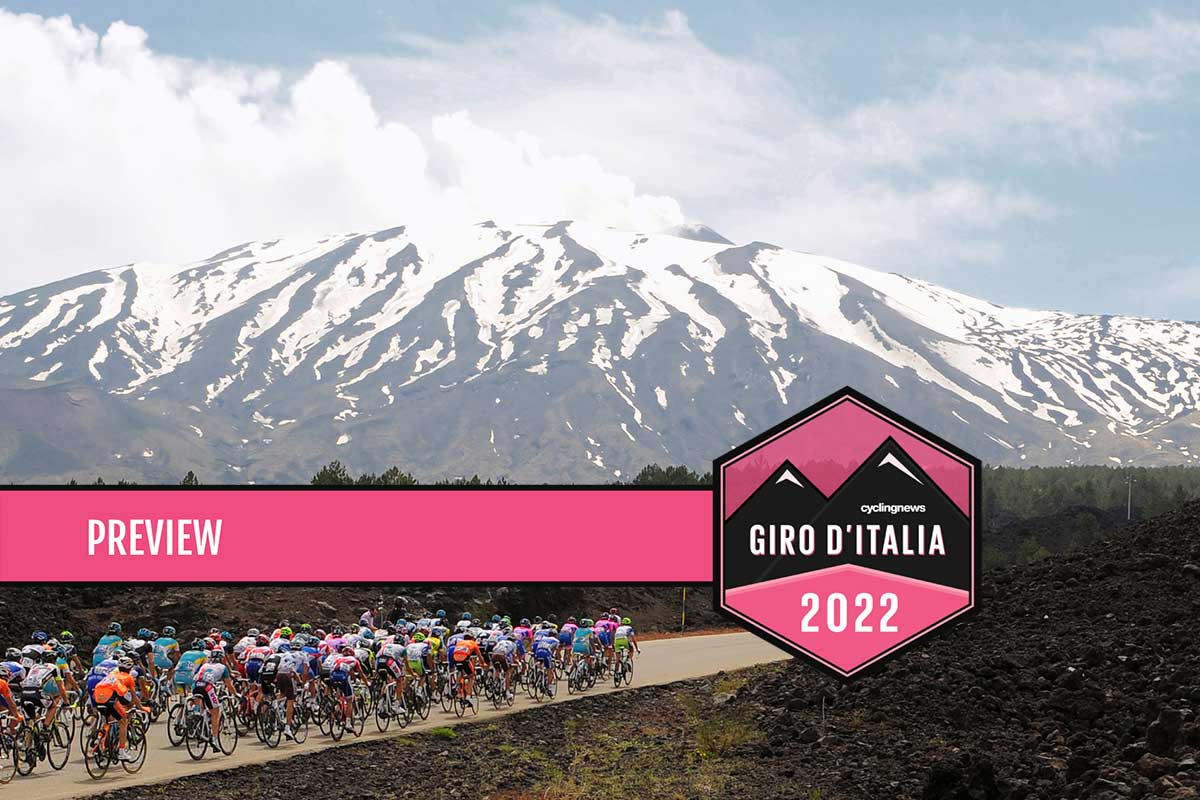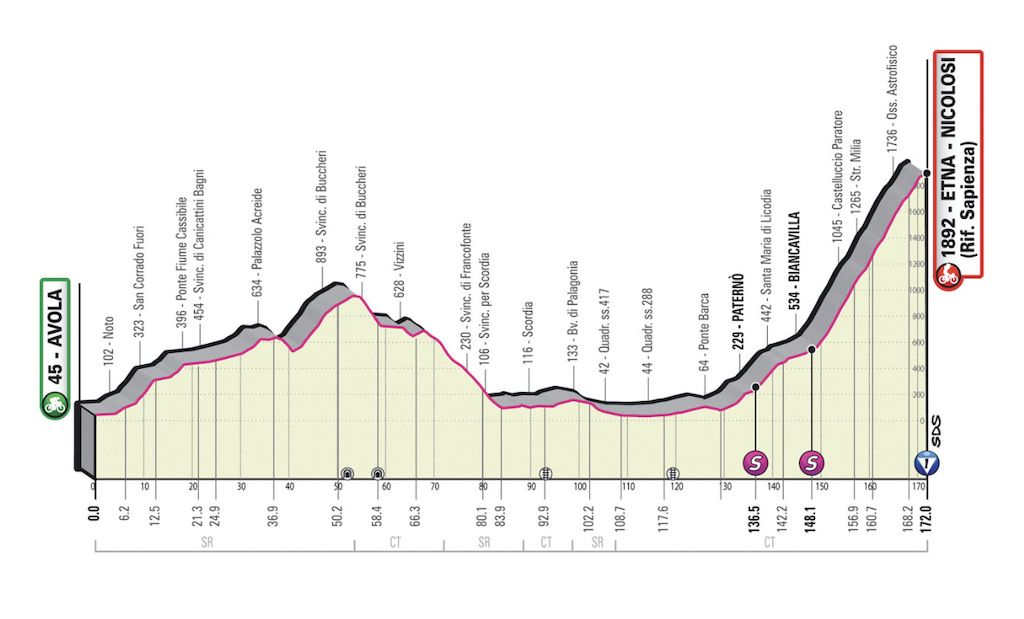Etna to shed new light on Giro d'Italia picture – Preview
Sicilian ascent could reveal much about Yates, Dumoulin and Carapaz

In 1949, when the Giro d’Italia made what was only its second visit to Sicily, the writer Dino Buzzati imagined the disappointment of Mount Etna at being shrouded in clouds and unable to watch the race, which skirted around its base en route to Messina: “The same old rotten luck. The Giro hasn't come to Sicily for 19 years. It finally comes this year [and] I've been trying to shake off these rotten clouds for two days.”
These days, the volcano must be sick of the sight of the Giro d'Italia. RCS Sport has recently found a most willing partner in the Sicilian tourist board, and the corsa rosa has just arrived on the island for the fourth time in six years. And, as was the case on the three previous occasions, the centrepiece of the Sicilian interlude is a summit finish on Mount Etna.
The Giro has come to Sicily so often in recent years that most of the sala stampa could find the car-hire kiosk in Catania airport in their sleep. The trade-off is that every imaginable volcanic metaphor has already been dusted off and re-used several times over in their Etna copy. The Giro giveth and the Giro taketh away.
Mercifully, there have been subtle variations of route and circumstance during each of the Giro’s recent visits to Etna. In 2011 and 2018, Alberto Contador and Simon Yates laid down very clear statements of intent, even if, for very different reasons, neither man would go on to win the Giro. In 2017 and 2020, on the other hand, the picture was altogether more muddled, with the contenders unwilling or perhaps simply unable to show their hands.
Etna, in other words, could go either way. A summit finish this early in a Grand Tour has the obvious potential to catch out those who come in undercooked. But with 16 stages still remaining, not many will be inclined to turn the heat up this far from Verona. As in 2017, this stage comes immediately after a rest day and transfer, which adds its own complications.
“I think it’s the rest day that’s going to be hard to manage,” Guillaume Martin (Cofidis) warned Cyclingnews before the Giro left Hungary. The riders travelled via two charter flights from Sármellék early on Monday morning, arriving at their hotels by lunchtime.
There wasn’t complete consensus on how to manage the aftermath of the transfer. Some teams, UAE Team Emirates included, opted for a simple session on the turbo trainer. Others, like Bahrain Victorious, ventured out on the road, and some riders even took in a recon of Tuesday’s finishing climb, which is essentially a combination of the wooded, 2018 ascent from Ragalna and the familiar, exposed finale of 2011 and 2017 at Rifugio Sapienza.
Get The Leadout Newsletter
The latest race content, interviews, features, reviews and expert buying guides, direct to your inbox!
Mathieu van der Poel (Alpecin-Fenix) carries the maglia rosa into the stage and while there appear to be few limits on what the Dutchman can potentially achieve on any terrain, he has suggested that he is likely to concede the jersey here.
Simon Yates is, after his victory in the Budapest time trial, the best-placed man of the overall favourites, but it remains to be seen whether his BikeExchange-Jayco team are remotely enthusiastic about taking hold of the jersey this early. They held it for two weeks after Etna in 2018, after all, but they will likely cut their cloth differently this time out – not least because Yates clearly doesn’t have the same imperative to distance the time triallists as he did back then.
“I think it could be two stages in one, with a break staying clear and then the GC contenders racing behind,” Bahrain Victorious directeur sportif Franco Pellizotti told La Gazzetta dello Sport on Monday. “In the time trial, we saw who is going well. Now we’ll have to see if somebody wants to respond or if they prefer to wait.”
Pellizotti knows of what he speaks. When the Giro climbed Etna on the corresponding stage in 2017, he was delegated by his then-leader Vincenzo Nibali to attack from the group of overall favourites, but it provoked no real response. Men like Tom Dumoulin and Nairo Quintana preferred to wait for the following weekend’s summit finish on the Blockhaus, which, coincidentally, also features on stage 9 this year.
The earliness of the stage, the openness of this Giro and the concerns about managing the effects of the rest day could add up to similar caution from the favourites on Mount Etna this time around, but there ought to be some early indications of form lines all the same.
It was difficult to extrapolate too much from Saturday’s short time trial in Budapest beyond Yates’ obvious good form and improved time trialling. The 22km haul up Etna should sketch out the contours of this Giro a little more clearly, as it did even in 2020, when João Almeida rode himself quietly into the pink jersey.
Richard Carapaz (Ineos) lost a surprising amount of time on the short climb at the end of the time trial on Saturday; Etna should confirm if that was simply a blip. Injury and illness mean that Tom Dumoulin (Jumbo-Visma) hasn’t been seen climbing strongly yet this year; Etna should offer a real indication of his readiness. Pello Bilbao and Mikel Landa line up as a redoubtable Basque tandem; Etna should provide clues as to Bahrain Victorious’ approach.
The route and the weather

Stage 4 sets out from Avola, home of the former professional Paolo Tiralongo, and so traverses Sicily’s most acclaimed wine country, climbing gradually towards Buccheri in the opening 50km. That unclassified climb offers a clear springboard for an early break to form, and it remains to be seen which teams, if any, will be motivated to chase on the long, flat approach to the base of Mount Etna.
In the finale, the road is already climbing between the intermediate sprints at Paternò and Biancavilla, but the category 1 ascent of Etna begins officially with 22km remaining. The lower half of the climb is largely wooded and sheltered, as was the case in 2018, and the gradient is steady at this point, toggling between 6 and 7%.
These are, in the words of Sicilian writer Giovanni Verga, “woods that tremble, that murmur, that stir,” though the greatest stirring here might come as the vegetation grows sparser and then disappears further up the climb. The toughest segment of the ascent begins with a little over 10km to go, with brief pitches of 14% at one point, and the most sustained slopes come between 8km and 6km to go.
The gradient very gradually eases off thereafter as the route winds towards the astrophysical observatory, but the exposed nature of the road brings its own difficulties, particularly with the cold weather for Tuesday. Mercifully, the Giro will ‘only’ climb as far as Rifugio Sapienza, 1,892m above sea level, but the temperature will be in single digits by the time the gruppo reaches the summit. The heavy rain that fell on Monday, however, is not expected to repeat itself during the stage.
“Suddenly you get up there and there’s nothing anymore, it’s a bit like Mont Ventoux,” said Guillaume Martin, who based himself at Rifugio Sapienza during an April training camp. “There’s just the lava: no noise, no birds, no vegetation.”
This Giro might not boil over on Mount Etna, but there is nowhere to hide either.

Barry Ryan was Head of Features at Cyclingnews. He has covered professional cycling since 2010, reporting from the Tour de France, Giro d’Italia and events from Argentina to Japan. His writing has appeared in The Independent, Procycling and Cycling Plus. He is the author of The Ascent: Sean Kelly, Stephen Roche and the Rise of Irish Cycling’s Golden Generation, published by Gill Books.